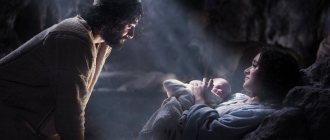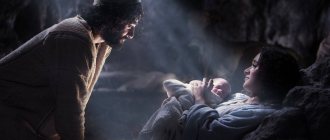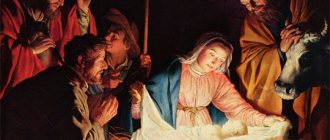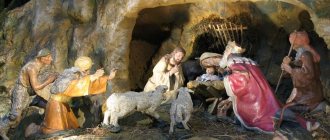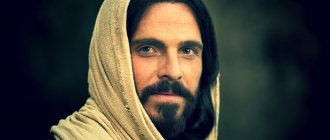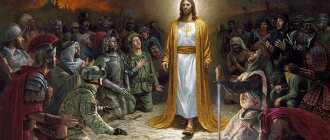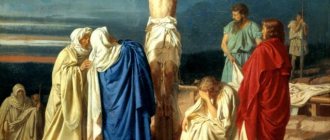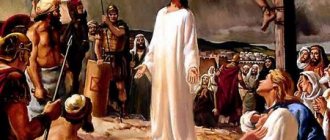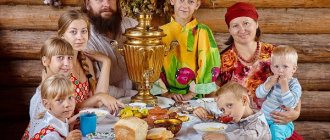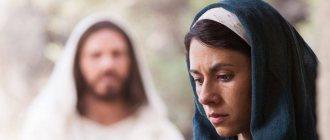Cave of the Nativity
,
Grotto of the Nativity
,
Holy Nativity Scene
- the greatest Christian shrine, a cave in the rock where Jesus Christ was born from the Virgin Mary.
Located under the pulpit of the Basilica of the Nativity in Bethlehem. In surviving written sources it was first mentioned around the year 150. An underground temple has been located here since the time of St. Helena. Belongs to the Jerusalem Orthodox Church.
Christmas place
The birthplace of Christ is marked by a silver star, which is set into the floor and was once gilded and decorated with precious stones. The star has 14 rays and symbolizes the Star of Bethlehem[1], inside the circle there is an inscription in Latin: “ Hic de virgine Maria Iesus Christus Natus est
"("Here Jesus Christ was born from the Virgin Mary"). Above this star, in a semicircular niche, hang 16 lamps, of which 6 belong to the Orthodox, 6 to the Armenians and 4 to the Catholics. Behind these lamps, in a semicircle on the wall of a niche, are small Orthodox icons. Two more small glass lamps are simply standing on the floor, right behind the star, against the wall.
Directly above the Nativity site is an Orthodox marble throne. Only Orthodox Christians and Armenians have the right to celebrate the liturgy on this throne. In front, the throne rests on two small marble columns, and in the niche above it there are small fragments of Byzantine mosaics.[2] When there is no service, the altar is covered with a special removable grille. Behind the throne on the wall are six small Orthodox icons.
Manger Chapel
In the southern part of the cave, to the left of the entrance, there is a manger chapel. This is the only part of the cave that is run by Catholics. It resembles a small chapel measuring approximately 2x2 m, or a little more, the floor level in it is two steps lower than in the main part of the cave. In this chapel, to the right of the entrance, is the place of the Manger, where Christ was laid after his birth. Actually, the Manger is a feeding trough for domestic animals that was in the cave; the Most Holy Theotokos, of necessity, used it as a cradle. The interior of the Manger was taken as a great shrine to Rome to the church of Santa Maria Maggiore, where it is known under the names Sacra culla, Cunambulum or Praesepe. This was done in the middle of the 7th century, under Pope Theodore I, a few years after the seizure of the Holy Land by Muslims, perhaps in order to prevent desecration of the shrine. The same part of the Manger that remained in Bethlehem was covered with marble and now represents a recess in the floor, arranged in the form of a cradle, above which five unquenchable lamps burn. Behind these lamps, near the wall, there is a small image depicting the worship of the Bethlehem shepherds to the Child[2].
In the chapel of the Manger, to the left of the entrance to it, there is a Catholic altar of the Adoration of the Magi[3]. The altarpiece located here depicts the adoration of the Magi to Christ[2].
Construction of a theatrical nativity scene
In order to better understand what a nativity scene is, let’s look at its structure. As already mentioned, most often the den house consisted of two or three floors. In fact, a nativity scene is such a small model of the Universe, the world above and the world below. At the top, scenes related to the birth of Jesus Christ were played out. This half was covered with blue paper; in the back there was a manger, around which stood figures of the Holy Family, Magi, angels and domestic animals.
The lower part was occupied by the palace of King Herod; various comic situations usually took place here. This part of the box was decorated with bright paper, and Herod himself sat on the throne. There were slots at the bottom and top of the box through which the dolls could move along the stage. There were opening doors on the sides. The dolls could not move from one tier to another.
Dolls were most often made of wood, sometimes of clay. They were painted, dressed in beautiful paper or woven clothes, and finally rods were attached to them, thanks to which the dolls could move around the stage.
Depending on the size, the boxes could be carried on a sleigh, carried on hand, or installed permanently.
Description of the cave
The cave measures 12.3 x 3.5 m and 3 m in height, that is, it is quite narrow and long, oriented along a west-east line. The Nativity site is located at its eastern end. Two staircases from the time of Justinian the Great[1], northern and southern, lead to the cave, each consisting of 15 porphyry steps. The northern staircase belongs to Catholics, the southern to Orthodox and Armenians, they are located in the eastern part of the cave, symmetrically on both sides of it. Usually pilgrims descend along the southern stairs and ascend along the northern one. These entrances acquired their current appearance in the 12th century, when bronze doors from the 5th and 6th centuries were enclosed in marble portals, and the lunettes above the doors were decorated with stone carvings. The floor of the cave and the lower part of the walls are decorated with light marble, the rest is draped with fabric or covered with 19th-century trellises, and icons are hung on the walls. The ceiling is heavily smoked, 32 lamps are suspended on it, and there are 53 of them in the cave, and this number has not changed for a long time.[2] The cave has no natural light; it is currently illuminated by electricity and, partly, by lamps and candles.
In the western wall of the cave there is a door that leads to the northern part of the system of grottoes located under the basilica, including the grotto in which St. Jerome of Stridon lived. As a rule, this door is locked.
The ancient silver and gold star was stolen in 1847 (it is unknown by whom, but most likely by the Turks). This theft became a new reason for mutual grievances between Orthodox Greeks and Catholics and even partially awakened in 1848 the “question of Holy Places” (see Crimean War). The star that can be seen now was made according to the exact model of the ancient one and strengthened in 1847 by order of Sultan Abdulmecid I and at his expense.[2]
For the first time, the cave of the Nativity was described in Russian at the beginning of the 12th century by Abbot Daniel, in the essay “ The Life and Walking of Abbot Daniel from the Russian Land”
»:
|
Nativity scene in Russia
In Russia, they showed greater interest in theatrical nativity scenes (in Europe, of course, they existed, but were not so popular). This word was used to describe both short performances based on Christmas scenes and two- or three-story houses in which the action took place.
Nativity scene art especially flourished by the 19th century. In St. Petersburg, by this time, there was even a dynasty of nativity scene makers, the Kolosov family, who kept and passed on the secrets of Christmas performances (similar phenomena are still found in Europe - for example, in modern Naples there is a street full of nativity scene workshops). By the end of the century, nativity scene masters traveled throughout the country - all of Russia already knew what a nativity scene was. It became a much more secular art than before, and the Christmas mystery ended with a completely secular comedy with local colorful humor.
The artists walked with boxes not only on Christmas Eve, but also further, right up to Maslenitsa, and even until the summer. The revolution of 1917 broke this tradition, and soon enough the construction of nativity scenes, the texts of performances, and the secrets of making dolls were forgotten until the end of the 20th century. Folklorists under the leadership of D. Pokrovsky began restoring nativity boxes only in the 1980s; it was their experiments that were ultimately taken as the basis for the revived tradition.
First mention of the cave
The canonical texts do not speak directly about the cave. The evangelists Luke (Luke 2:4-7) and Matthew (Matthew 2:1-11) report that Christ was born in Bethlehem, but none of them mentions the cave, only Luke indirectly points to it, reporting that the Mother of God “laid Him into a manger because there was no room for them in the inn”
(Luke 2:7).
The oldest direct written evidence that has probably reached us about the cave as the place of the Nativity belongs to St. Justin the Philosopher. In the essay “Dialogue with Tryphon the Jew”
, written in 150-155, he claims that the Holy Family took refuge in a cave near Bethlehem[5].
The cave as the site of the Nativity is mentioned many times in the apocryphal Proto-Gospel of James (chapters 18-21), presumably written around the year 150. Origen visited Bethlehem almost a century before the construction of the Basilica of the Nativity, around 238[6]. Later, in his work Against Celsus
, written around 247, he mentions a cave in Bethlehem, which local residents considered the site of the Nativity of Christ[7].
Origin of the cave
What kind of cave it was and who it belonged to is unknown. Most likely, it was of natural origin, and later it was adapted for household needs, including for keeping pets. In Bethlehem, many old buildings are built over caves in the limestone cliffs. Often houses located on a slope have a cave on their first floor, the entrance to which is at street level. This floor was used as a stable, and the family lived on the second floor. Many of these rooms have stone troughs or mangers carved into the rock, as well as iron rings so that animals can be tied up at night. These caves, exactly the same as the Nativity Grotto, were used to keep animals until the mid-20th century. Perhaps Christ was born in one of these caves.[8]
Man-made nativity scene
Sometimes the appearance of man-made nativity scenes is attributed to Francis of Assisi, who created such a living panorama as a reminder of the original holiday. This is unlikely, but in any case, from the 12th-13th centuries, static compositions from a variety of materials began to appear in Europe, which depicted the Holy Family, angels, shepherds and other participants in the Nativity scene. Often they were presented in conditions that corresponded to modernity, and not to ancient Jewish life. Mystery plays in which the Birth of the Savior was depicted in person were also popular.
Gallery
- Cave of Nativity Entrance.jpg
Northern entrance to the Nativity Cave, service in progress below
- Grotto of the Nativity Orthodox Altar.jpg
Orthodox throne over the Nativity site in a cave
- Grotto of the Nativity West Part.jpg
Western part of the cave. A door leading to other caves located under the church is visible
- Grotto of the Nativity South Entrance Lunette.jpg
Lunette of the southern entrance to the Cave of the Nativity, 12th century, legacy of the Crusaders
Manger Chapel
- Manger in Grotto of the Nativity.jpg
Manger Chapel
- Grotto of the Nativity Manger.jpg
Child Christ on the throne in the Manger. Catholic chapel of the Manger during Christmas time
- Grotto of the Nativity Catholic Altar.jpg
Catholic altar of the Adoration of the Magi in the chapel of the Manger
- Grotto of the Nativity Icon Above Manger.jpg
The icon is directly above the Manger
Notes
- ↑ 1 2
Holy Land. Historical guide to memorable places in Israel, Egypt, Jordan and Lebanon / Ed. M. V. Bibikov. M., 2000. P.96 - ↑ 1 2 3 4 5
Archimandrite Leonid Kavelin. Old Jerusalem and its surroundings. From the notes of a monk-pilgrim. M.: Indrik, 2008. P.269-276 - Timaev
N. Jerusalem and Palestine. Ch. 85. Personalities Jesus Christ • Virgin Mary • Joseph the Betrothed • Salome the Midwife • Three Kings • Herod the Great Related events Star of Bethlehem • Massacre of the Innocents • Flight into Egypt Places Bethlehem • Cave of the Nativity and Manger Celebration traditions Christmas tree • Christmas Eve • Advent • Christmastide • New Year • Old New Year • Secret Santa • Christmas goat • Walking with a star Christmas by country Argentina • Russia • Ukraine • Finland • Sweden • Japan
Where to stay[edit]
Pilgrim Residence
- Pilgrim's House in Bethlehem
In light of the emerging stability and further settlement of the situation in Palestine, the Russian Orthodox Church opened the Pilgrim Residence in Bethlehem, expressing hope for the possibility of further peaceful coexistence of the peoples of the Holy Land.
The pilgrim's house in Bethlehem is located 200 meters from the great Christian shrine - the Church of the Nativity. Thanks to this location, every morning guests have the opportunity to pray during the Divine Liturgy in the cave where the Lord Jesus Christ was born.
The hotel creates all the necessary conditions so that every pilgrim visiting the Holy Land feels the cordiality and hospitality of the Holy City of Bethlehem and retains the joy of the Nativity of Christ in his heart for a long time.
The hotel was built in 2000 with the blessing of His Holiness Patriarch Alexy II of Moscow and All Rus'.
Near the great Christian shrine, the Residence provides for a comfortable and safe stay:
- 62 standard rooms for accommodation from 1 to 3 people.
- 8 VIP suites.
- Presidential Suite with Jacuzzi, elevator and study.
Accommodation in the Pilgrim House in Bethlehem is carried out through the Pilgrimage Service of the Russian Spiritual Mission.
Address:
Pilgrim Residence. 73, Milky Grotto Street, Bethlehem.
Mailing address:
Pilgrim Residence. 73, Milky Grotto Street, Bethlehem, Palestine POB436
Phones:
+972 (2) 276-60-40, fax: +972 (2) 276-60-41; +972 (2) 625-00-94 (Pilgrimage service of the Russian Spiritual Mission).
Email:
Excerpt characterizing the Cave of the Nativity
“Here, eat, master,” he said, again returning to his former respectful tone and unwrapping and handing Pierre several baked potatoes. - There was stew at lunch. And the potatoes are important! Pierre had not eaten all day, and the smell of potatoes seemed unusually pleasant to him. He thanked the soldier and began to eat. - Well, is that so? – the soldier said smiling and took one of the potatoes. - And that’s how you are. - He took out a folding knife again, cut the potatoes into equal two halves in his palm, sprinkled salt from a rag and brought it to Pierre. “The potatoes are important,” he repeated. - You eat it like this. It seemed to Pierre that he had never eaten a dish tastier than this. “No, I don’t care,” said Pierre, “but why did they shoot these unfortunates!.. The last twenty years.” “Tch, tsk...” said the little man. “This is a sin, this is a sin...” he quickly added, and, as if his words were always ready in his mouth and accidentally flew out of him, he continued: “What is it, master, that you stayed in Moscow like that?” “I didn’t think they would come so soon.” “I accidentally stayed,” said Pierre. - How did they take you, falcon, from your house? - No, I went to the fire, and then they grabbed me and tried me for an arsonist. “Where there is court, there is no truth,” the little man interjected. - How long have you been here? – asked Pierre, chewing the last potato. - Is that me? That Sunday they took me from the hospital in Moscow. -Who are you, soldier? - Soldiers of the Absheron Regiment. He was dying of fever. They didn't tell us anything. About twenty of us were lying there. And they didn’t think, they didn’t guess. - Well, are you bored here? asked Pierre. - It’s not boring, falcon. Call me Plato; Karataev’s nickname,” he added, apparently in order to make it easier for Pierre to address him. - They called him Falcon in the service. How not to be bored, falcon! Moscow, she is the mother of cities. How not to get bored looking at this. Yes, the worm gnaws at the cabbage, but before that you disappear: that’s what the old men used to say,” he added quickly. - How, how did you say that? asked Pierre. - Is that me? – asked Karataev. “I say: not by our mind, but by God’s judgment,” he said, thinking that he was repeating what had been said. And he immediately continued: “How come you, master, have estates?” And there is a house? Therefore, the cup is full! And is there a hostess? Are your old parents still alive? - he asked, and although Pierre could not see in the darkness, he felt that the soldier’s lips were wrinkled with a restrained smile of affection while he was asking this. He was apparently upset that Pierre did not have parents, especially a mother. “A wife is for advice, a mother-in-law is for greetings, and nothing is dearer than your own mother!” - he said. - Well, are there any children? – he continued to ask. Pierre's negative answer again apparently upset him, and he hastened to add: “Well, there will be young people, God willing.” If only I could live in the council... “It doesn’t matter now,” Pierre said involuntarily. “Eh, you’re a dear man,” Plato objected. - Never give up money or prison. “He sat down better and cleared his throat, apparently preparing for a long story. “So, my dear friend, I was still living at home,” he began. “Our patrimony is rich, there is a lot of land, the men live well, and our home, thank God.” The priest himself went out to mow. We lived well. They were real Christians. It happened... - And Platon Karataev told a long story about how he went to someone else’s grove behind the forest and was caught by a guard, how he was whipped, tried and handed over to the soldiers. “Well, the falcon,” he said, his voice changing with a smile, “they thought grief, but joy!” My brother should go, if it were not for my sin. And the younger brother has five boys himself - and look, I have only one soldier left. There was a girl, and God took care of her even before she became a soldier. I came on leave, I’ll tell you. I see they live better than before. The yard is full of bellies, women are at home, two brothers are at work. Only Mikhailo, the youngest, is at home. Father says: “All children are equal to me: no matter what finger you bite, everything hurts. If only Plato hadn’t been shaved then, Mikhail would have gone.” He called us all - believe me - he put us in front of the image. Mikhailo, he says, come here, bow at his feet, and you, woman, bow, and your grandchildren bow. Got it? speaks. So, my dear friend. Rock is looking for his head. And we judge everything: sometimes it’s not good, sometimes it’s not okay. Our happiness, my friend, is like water in delirium: if you pull it, it swells, but if you pull it out, there’s nothing. So that. - And Plato sat down on his straw. After being silent for some time, Plato stood up. - Well, I have tea, do you want to sleep? - he said and quickly began to cross himself, saying: “Lord, Jesus Christ, St. Nicholas, Frol and Lavra, Lord Jesus Christ, St. Nicholas!” Frol and Lavra, Lord Jesus Christ - have mercy and save us! - he concluded, bowed to the ground, stood up and, sighing, sat down on his straw. - That's it. “Put it down, God, like a pebble, lift it up like a ball,” he said and lay down, pulling on his greatcoat. -What prayer were you reading? asked Pierre. - Ass? - said Plato (he was already falling asleep). - Read what? I prayed to God. Don’t you ever pray? “No, and I pray,” said Pierre. - But what did you say: Frol and Lavra? “But what about,” Plato quickly answered, “a horse festival.” And we must feel sorry for the livestock,” Karataev said. - Look, the rogue has curled up. She got warm, the son of a bitch,” he said, feeling the dog at his feet, and, turning around again, immediately fell asleep. Outside, crying and screams could be heard somewhere in the distance, and fire could be seen through the cracks of the booth; but in the booth it was quiet and dark. Pierre did not sleep for a long time and, with open eyes, lay in his place in the darkness, listening to the measured snoring of Plato, who lay next to him, and felt that the previously destroyed world was now being erected in his soul with new beauty, on some new and unshakable foundations. In the booth into which Pierre entered and in which he stayed for four weeks, there were twenty-three captured soldiers, three officers and two officials. All of them then appeared to Pierre as if in a fog, but Platon Karataev remained forever in Pierre’s soul as the strongest and dearest memory and personification of everything Russian, kind and round. When the next day, at dawn, Pierre saw his neighbor, the first impression of something round was completely confirmed: the whole figure of Plato in his French overcoat belted with a rope, in a cap and bast shoes, was round, his head was completely round, his back, chest, shoulders, even the hands that he carried, as if always about to hug something, were round; a pleasant smile and large brown gentle eyes were round. Platon Karataev must have been over fifty years old, judging by his stories about the campaigns in which he participated as a long-time soldier. He himself did not know and could not determine in any way how old he was; but his teeth, bright white and strong, which kept rolling out in their two semicircles when he laughed (which he often did), were all good and intact; There was not a single gray hair in his beard or hair, and his whole body had the appearance of flexibility and, especially, hardness and endurance. His face, despite the small round wrinkles, had an expression of innocence and youth; his voice was pleasant and melodious. But the main feature of his speech was its spontaneity and argument. He apparently never thought about what he said and what he would say; and because of this, the speed and fidelity of his intonations had a special irresistible persuasiveness. His physical strength and agility were such during the first time of captivity that it seemed that he did not understand what fatigue and illness were. Every day, in the morning and in the evening, when he lay down, he said: “Lord, lay it down like a pebble, lift it up into a ball”; in the morning, getting up, always shrugging his shoulders in the same way, he said: “I lay down and curled up, got up and shook myself.” And indeed, as soon as he lay down, he immediately fell asleep like a stone, and as soon as he shook himself, he immediately, without a second of delay, took up some task, like children, getting up, taking up their toys. He knew how to do everything, not very well, but not badly either. He baked, steamed, sewed, planed, and made boots. He was always busy and only at night allowed himself conversations, which he loved, and songs. He sang songs, not as songwriters sing, who know that they are being listened to, but he sang like birds sing, obviously because he needed to make these sounds just as it is necessary to stretch or disperse; and these sounds were always subtle, gentle, almost feminine, mournful, and at the same time his face was very serious. Having been captured and grown a beard, he apparently threw away everything alien and soldierly that had been imposed on him and involuntarily returned to his former, peasant, folk mindset. “A soldier on leave is a shirt made from trousers,” he used to say. He was reluctant to talk about his time as a soldier, although he did not complain, and often repeated that throughout his service he was never beaten. When he spoke, he mainly spoke from his old and, apparently, dear memories of “Christian”, as he pronounced it, peasant life. The sayings that filled his speech were not those, mostly indecent and glib sayings that soldiers say, but they were those folk sayings that seem so insignificant, taken in isolation, and which suddenly take on the meaning of deep wisdom when they are spoken opportunely. Often he said the exact opposite of what he had said before, but both were true. He loved to talk and spoke well, decorating his speech with endearments and proverbs, which, it seemed to Pierre, he was inventing himself; but the main charm of his stories was that in his speech the simplest events, sometimes the very ones that Pierre saw without noticing them, took on the character of solemn beauty. He loved to listen to fairy tales that one soldier told in the evenings (all the same ones), but most of all he loved to listen to stories about real life. He smiled joyfully as he listened to such stories, inserting words and making questions that tended to clarify for himself the beauty of what was being told to him. Karataev had no attachments, friendship, love, as Pierre understood them; but he loved and lived lovingly with everything that life brought him to, and especially with a person - not with some famous person, but with those people who were before his eyes. He loved his mongrel, he loved his comrades, the French, he loved Pierre, who was his neighbor; but Pierre felt that Karataev, despite all his affectionate tenderness towards him (with which he involuntarily paid tribute to Pierre’s spiritual life), would not for a minute be upset by separation from him. And Pierre began to feel the same feeling towards Karataev.
Nativity scene
The play is based on the story of the coming of Christ into our world. When he is born, angels and wise men come to worship him. The latter later tell about the joyful news to King Herod, who, in fear that the newly arrived King in the world will sooner or later take away his power, orders the killing of the infants of the city of Bethlehem. Rachel comes to the king, crying for her children, but Herod does not want to listen to requests for mercy. But an Angel descends from heaven to console Rachel, and the king is visited by Death, in turn, not listening to his requests for a reprieve. Death tells the Devil to take Herod to hell, which he does. This plot occupies the first part of the performance.
The second part is devoted to everyday humorous scenes, which vary in duration and content - depending on the area where the nativity play is shown. Usually the plot for them was scattered stories dedicated to dances or fights of various colorful characters: gypsies, fashionable young ladies, men, Jews, soldiers, etc. Over time, the second part of the performance took more and more time, reducing the duration of the “serious” part, turning the action into purely secular entertainment.
